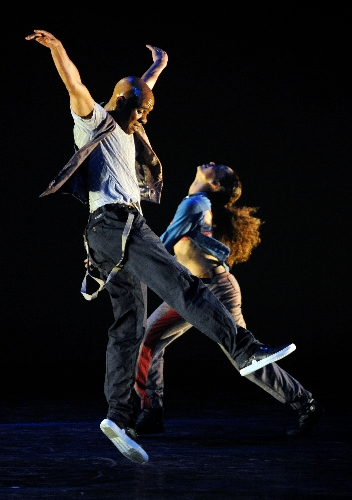Ailey troupe’s finale still a national treasure

Speaking volumes without saying a word.
It’s an undeniable, if almost indescribable, art — one that the members of the Alvin Ailey American Dance Theater have mastered.
Making their Smith Center debut Tuesday night in Reynolds Hall, the Ailey dancers delivered a stirring, soulful program that spanned a half-century of dance — and proved how truly timeless that legacy is. (The troupe also was scheduled to perform two shows Wednesday: a special performance for local students in the morning, followed by a different program Wednesday night.)
Every Ailey performance concludes with the founder’s 1960 classic "Revelations." (We’ll get to that later.)
But Tuesday’s program also spotlighted the choreography of the company’s new artistic director, Robert Battle, with a trio of pieces by turns witty ("Takademe"), visceral ("The Hunt") and passionate ("In/Side" ).
Tuesday’s opener, however, belonged to a new work: "Home," from hip-hop choreographer Rennie Harris.
Set to gospel house music, inspired by the writings of people living with HIV/AIDS (founder Ailey died as a result of AIDS more than two decades ago), "Home" showed the dancers at home in loose, yet precise, style.
Weaving in and out to the percolating beat, guest artist Matthew Rushing (the Ailey rehearsal director) led the troupe through a series of group moves, each dancer seemingly gaining strength from the others as they struggled to endure literal life-and-death trials. (The work’s stylistic echoes of "Revelations" — from hand-claps to arms, and eyes, raised skyward — effectively bookended the evening.)
Battle’s trio of dances took the troupe — and the audience — through more varied territory.
In the 1999 solo "Takademe," the tightly interwoven rhythms of Indian Kathak dance inspired a short but stunning study of percussive movement. Show-stopping soloist Kirven James Boyd played tag with Sheila Chandra’s droning soundtrack, his impish interplay reflecting not only the hypnotic movement but the humor of the dance.
In Battle’s dramatic, emphatic "The Hunt" (2001), six male dancers assembled to thundering tribal drums (Les Tambours du Bronx provided the pounding soundtrack) that powered the ritualistic movements. Sometimes they recalled gladiator combat. Sometimes they recalled more contemporary stadium moves. Either way, they reflected the push-pull of relationships that can shift between cooperation and confrontation in a heartbeat.
"In/Side" (2008) set the stage for another spellbinding solo — this one from Samuel Lee Roberts — to Nina Simone’s haunting "Wild Is the Wind." Buffeted by stormy emotions, Roberts’ swirling, twisting movements conveyed the irresistible passions the song’s sultry lyrics suggest.
And then it was time to go home — to Ailey’s "Revelations."
The troupe’s signature dance suite may be a true national treasure, but it remains a vibrant one — and a rousing finale that shifted the dancers into a higher gear. (If such a thing is possible.)
Unlike the program’s other dances — performed on a stark, bare stage, with shifting lighting setting the mood — "Revelations" burst forth with a different, heightened energy. Costumes! Props! Simple scenic effects! All suggested a less abstract, more evocative world, reflected in the expressive, spiritual-laden soundtrack.
From "Sinner Man" to "Wade in the Water," this dance suite is in the Ailey DNA — and, by the time the entire company took the stage for the concluding spiritual, "Rocka My Soul in the Bosom of Abraham," Reynolds Hall was rocking, the cheering audience clapping and singing along in an outpouring of infectious, kinetic joy.
It’s the art of speaking to the heart — and the Ailey dancers, individually and collectively, provided exhilarating evidence of its power.
Contact reporter Carol Cling at ccling@reviewjournal.com or 702-383-0272.